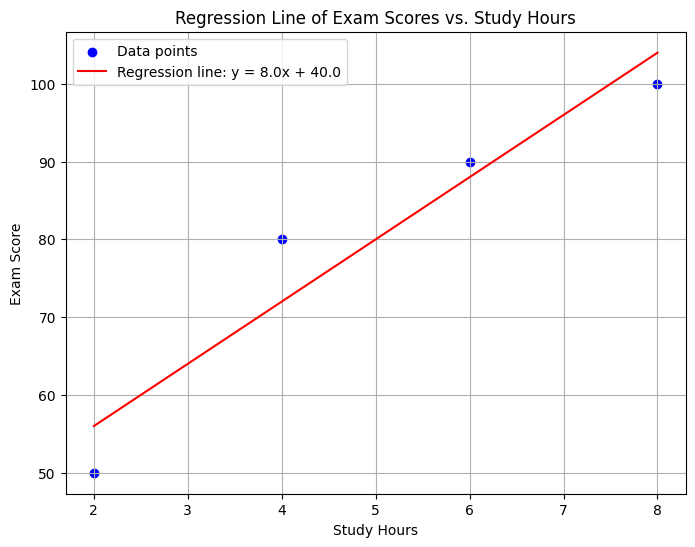Linear Regression
It is a simple linear equation that predicts the value of a dependent variable based on a single independent variable. It is also known as a regression line.
It is a linear regression model that uses a single independent variable and a single dependent variable. It is also known as a univariate regression model.
for example: predicting exam score based on study hours
here we have a single independent variable(study hours) and a single dependent variable(exam score). the more you study the more marks we can predict to the exam score.
lets create a simple dataset to predict the exam score based on study hours.
| Study Hours | Exam Score |
|---|---|
| 2 | 50 |
| 4 | 80 |
| 6 | 90 |
| 8 | 100 |
we have a simple linear regression model that predicts the exam score based on study hours. we have a formula of regression line which is
y = mx + b
where y is the dependent variable,(the variable we want to predict),
m is the slope,(the change in the dependent variable for each unit change in the independent variable),
x is the independent variable,(the variable we are using to predict the dependent variable),
b is the intercept.(the value of the dependent variable when the independent variable is zero)
lets create table to calculate the slope and intercept
| Study Hours | Exam Score | mean(x) | mean(y) | deviation(x-mean(x)) | deviation(y-mean(y)) | product of deviation(x,y) | sum of product of deviation(x,y) | square of deviation(x) |
|---|---|---|---|---|---|---|---|---|
| 2 | 50 | 5 | 80 | -3 | -30 | 90 | 160 | 9 |
| 4 | 80 | -1 | 0 | 0 | 1 | |||
| 6 | 90 | 1 | 10 | 10 | 1 | |||
| 8 | 100 | 3 | 20 | 60 | 9 |
now to calculate the slope and intercept we need to calculate the sum of product of deviation(x,y) and sum of square of deviation(x).
sum of product of deviation(x,y) = 160 sum of square of deviation(x) = 20
slope = sum of product of deviation(x,y) / sum of square of deviation(x) slope = 160 / 20 slope = 8
intercept = mean(y) - slope _ mean(x) intercept = 80 - 8 _ 5 intercept = 40
regression line = y = mx + b regression line = 8x + 40
code to plot the regression line in the graph
import numpy as np
import matplotlib.pyplot as plt
# Given data
study_hours = np.array([2, 4, 6, 8])
exam_scores = np.array([50, 80, 90, 100])
mean_x = 5
mean_y = 80
# Calculate the slope and intercept
sum_product_deviation_xy = 160
sum_square_deviation_x = 20
slope = sum_product_deviation_xy / sum_square_deviation_x
intercept = mean_y - slope * mean_x
# Regression line equation
x_line = np.linspace(min(study_hours), max(study_hours), 100)
y_line = slope * x_line + intercept
# Plot the data points and regression line
plt.figure(figsize=(8, 6))
plt.scatter(study_hours, exam_scores, color='blue', label='Data points')
plt.plot(x_line, y_line, color='red', label=f'Regression line: y = {slope:.1f}x + {intercept:.1f}')
plt.title('Regression Line of Exam Scores vs. Study Hours')
plt.xlabel('Study Hours')
plt.ylabel('Exam Score')
plt.legend()
plt.grid(True)
plt.show()
# Check if the solution provided matches calculated results
slope, intercept
lets get x and y points to plot the regression line
| Study Hours | Exam Score |
|---|---|
| 2 | 56 |
| 4 | 72 |
| 6 | 88 |
| 8 | 104 |
code to get x and y points for linear regression
# import libraries and recalculate
import numpy as np
# Data points
study_hours = np.array([2, 4, 6, 8])
exam_scores = np.array([50, 80, 90, 100])
mean_x = 5
mean_y = 80
# Calculations
sum_product_deviation_xy = 160
sum_square_deviation_x = 20
slope = sum_product_deviation_xy / sum_square_deviation_x
intercept = mean_y - slope * mean_x
# Get specific points for the regression line
x_points = study_hours
y_points = slope * x_points + intercept
# Display x and y points
list(zip(x_points, y_points))

Advantages of Linear Regression
- Simple to understand and interpret.
- Easy to implement.
- Can handle outliers and noise. (An outlier is a data point that is noticeably different from the rest.)
Disadvantages of Linear Regression
- Can be sensitive to outliers.
- Can be affected by multicollinearity (high correlation between independent variables).
- Can be less accurate for non-linear relationships.
Question: Predicting Price Based on Area Using Linear Regression
You are assigned with analyzing the relationship between the area of a property (in square meters) and its price (in thousands of USD). Below is the dataset:
| Area (sq. m) | Price (*1000 USD) |
|---|---|
| 8 | 10 |
| 10 | 13 |
| 12 | 16 |
Instructions:
-
Using linear regression, determine the relationship between the area and price.
- Compute the slope and intercept of the regression line.
- Derive the equation of the regression line in the form ( y = mx + b ), where (y) represents the price, and (x) represents the area.
-
Plot the data points and the regression line on a graph:
- The (x)-axis should represent the area (sq. m).
- The (y)-axis should represent the price (*1000 USD).
-
Use the regression equation to predict the price of a property with an area of 18 sq. m.
Deliverables:
- The regression equation.
- A graph displaying the data points and the regression line.
- The predicted price for an area of 18 sq. m.